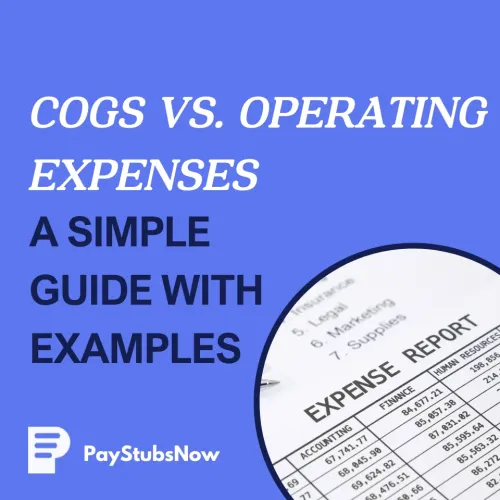


Navigating the complexities of financial statements can be overwhelming, particularly when distinguishing between Cost of Goods Sold (COGS) and operating expenses (OpEx). Both play crucial roles in determining a business's profitability and financial health, but understanding their differences is key to accurate financial reporting and efficient tax planning.
In this blog, we’ll break down the unique components of COGS and operating expenses, exploring how each impacts your bottom line. We will explain the key differences between these costs, how they are represented in financial statements, and their tax implications across various industries.
You'll also discover techniques to streamline financial management with Paystubsnow.

The cost of Goods Sold (COGS) refers to the direct costs involved in producing goods or services a company sells. These costs include materials, labor directly tied to manufacturing, and overhead expenses, which we will explore below.
Let’s break down the key components that make up COGS and why they matter for your business’s financial health.
This includes raw materials used to create a product or components purchased for assembly. Accurate tracking of material costs ensures proper pricing and profit margin calculations. These expenses fluctuate due to supplier rates, global supply chain issues, and bulk purchasing decisions.
This includes the wages, benefits, and payroll expenses of employees physically producing the goods. It refers to hands-on labor, such as machine operators, assembly line workers, or bakers in a bakery. Efficient labor use can reduce COGS, while overtime, turnover, or inefficiencies can raise it.
Manufacturing overhead includes indirect costs necessary for production but not tied to specific products. These can involve factory utilities, equipment depreciation, maintenance, and salaries of supervisors or quality control personnel. These expenses support the overall production environment.
To accurately calculate COGS, start by pinpointing all direct expenses related to producing goods. Sum these costs and incorporate the value of the beginning inventory, which represents the stock on hand at the start of the financial period. From this total, deduct the value of the closing inventory and the unsold goods by the period's end.
COGS = Beginning Inventory + Purchases + Direct Labor – Ending Inventory
Imagine a candle-making business tracking its COGS to determine profitability. Assume the company starts with $10,000 in inventory, purchases $5,000 in wax and wicks, and incurs $2,500 in labor costs. At the end of the period, the inventory is valued at $7,500. To calculate COGS, subtract the ending inventory from the sum of the starting inventory, purchases, and direct labor costs. This results in a COGS of $10,000, which is crucial in understanding gross profit margins.
COGS = $10,000 + $5,000 + $2,500 – $7,500 = $10,000
 Operating Expenses (OpEx) are the regular costs incurred for maintaining your business's day-to-day operations. Unlike COGS, which is directly tied to production, OpEx includes rent, utilities, marketing, administrative expenses, and depreciation, which we will explore below.
Operating Expenses (OpEx) are the regular costs incurred for maintaining your business's day-to-day operations. Unlike COGS, which is directly tied to production, OpEx includes rent, utilities, marketing, administrative expenses, and depreciation, which we will explore below.
Let's explore the types of operating expenses that are crucial for maintaining smooth operations and optimal productivity.
Rent refers to a business's regular capital expenditures for payments to use property, such as office space, retail stores, or warehouses. It's a fixed cost that typically recurs monthly and is essential for maintaining a physical business presence. Rent expenses vary widely depending on location and size.
These cover essential services like electricity, water, gas, internet, and phone lines required for daily core operations. These operating costs fluctuate based on usage, company size, and location. Managing utility expenses efficiently can contribute to cost savings and energy conservation.
These include digital campaigns, print ads, social media promotions, influencer partnerships, and event sponsorships. These expenses aim to drive brand awareness, customer engagement, and sales. Though variable, they are vital for business growth.
Administrative expenses are the overhead costs associated with running the day-to-day business that aren’t directly tied to production or sales. This includes office supplies, software subscriptions, indirect expenses like HR and finance staff salaries, and professional services like accounting or legal fees.
Depreciation represents the gradual reduction in value of tangible assets like machinery, vehicles, or office equipment over time. Although it’s a non-cash expense, depreciation affects financial reporting and tax calculations. It allows businesses to allocate the cost of assets over their useful life.
Start by pinpointing administrative operational expenses, including salaries and office supplies. Next, separate selling expenses such as marketing and advertising efforts . Finally, other overhead costs like utilities and depreciation are factored in. Once categorized, add the amounts to reach the total operating expenses. This total is crucial for understanding the company's financial health.
OpEx = Selling Expenses + General & Administrative (G&A) Expenses + Depreciation + Other Overhead
Imagine you own a bakery. For one month, your operating expenses include $2,000 for rent, $300 for utilities, $500 for marketing, $1,200 for administrative staff salaries and office supplies, and $400 in depreciation on your kitchen equipment.
These costs—totaling $4,400—are essential to keep your business running but are not directly tied to producing baked goods. Tracking these operating expenses separately from COGS allows you to calculate operating income accurately and assess overall financial performance.
OpEx =$2,000 + $300 + $500 + $1,200 + $400 = $4,400
After understanding these two financial concepts, let's break down the differences between the two below.
COGS typically includes direct costs like raw materials and labor tied to production. In contrast, OpEx includes indirect costs such as administrative costs, rent, utilities, office, marketing costs, and administrative salaries.
COGS appears directly beneath revenue on the company's income statement, allowing businesses to calculate gross profit . OpEx is listed below gross profit and includes all operating activities unrelated to production costs. This structure enables clearer visibility into a company’s cost structure.
COGS and OpEx both reduce taxable income, but tax authorities treat them differently. COGS is deductible only when inventory is sold, aligning with revenue generation. OpEx, however, is typically deductible in the year incurred, regardless of revenue.
 Let's now explore some real-world examples of the two to see how businesses categorize these costs in different industries.
Let's now explore some real-world examples of the two to see how businesses categorize these costs in different industries.
COGS in retail include inventory purchases, shipping, and packaging. For instance, a clothing store’s COGS might cover wholesale clothing costs and freight charges. Operating expenses include rent, utilities, advertising, and employee salaries.
Since no physical goods are sold, service-based businesses, such as a marketing agency, may have little or no COGS. However, direct costs like software subscriptions or freelance consultant fees could be classified as COGS. Operating expenses typically include office rent, salaries, and internet access.
In manufacturing, COGS encompasses raw materials, factory labor, and equipment maintenance—everything needed to produce goods. Operating expenses cover sales, administration, warehousing, and logistics not directly tied to production.
A freelance designer’s COGS might include all the costs for design software, project-specific assets, or subcontracted work. These are tied directly to delivering a client project. Operating expenses include a home office setup, internet bills, advertising, and accounting tools.
 Proper classification matters a lot when it comes to tax deductions. Let's understand why that is in detail below.
Proper classification matters a lot when it comes to tax deductions. Let's understand why that is in detail below.
Misclassification can lead to errors in tax filings, potentially resulting in penalties. Proper classification affects how expenses are treated under tax regulations, and businesses can deduct operating expenses if they are for-profit. This distinction ensures that you comply with IRS guidelines.
Accurate COGS influences profitability by determining the gross profit, calculated as revenue minus COGS, and the operating income, which is the gross profit minus OpEx. Misclassification can distort these figures, leading to inaccurate assessments of financial performance and risks.
Lastly, let's understand how to track COGs and operating expenses for businesses to gain a clearer financial picture and optimize cost structures.
Leverage accounting software like QuickBooks, Xero, or FreshBooks to automate COGS and expense tracking. These tools categorize transactions, generate reports, and minimize manual errors. With real-time insights into your financials, you can make informed decisions and spot issues early.
Create distinct categories for COGS and operating expenses in your chart of accounts. This separation improves reporting accuracy and simplifies tax preparation. Labeling categories such as rent, utilities, supplies, and inventory purchases helps you see where your money goes.
Reconcile your expense records regularly with bank and credit card statements—ideally monthly. This ensures accuracy, catches errors early, and prevents discrepancies that could affect financial reports. Staying on top of reconciliation also helps you maintain reliable records for audits.
Hiring a certified public accountant (CPA) or bookkeeper ensures your financials are tracked correctly. They provide expertise in expense classification, tax deductions, and compliance. Their guidance can also help you optimize cash flow, reduce unnecessary spending, and avoid costly accounting mistakes.
Payroll should be tracked separately from other operating expenses to reflect labor costs. This includes wages, benefits, and payroll taxes. Keeping payroll distinct helps with budgeting, profitability analysis, and tax reporting, especially if you calculate labor-related COGS for service-based businesses.
As you can see, streamlining your financial management is crucial to maintaining efficient business operations. Paystubsnow offers various solutions designed to help you achieve this goal effectively.
With services like paystub generation, invoice creation, and 1099 forms, Paystubsnow provides the tools to keep your financial records organized and easily accessible. We also help to precisely track payroll expenses, which can be classified as COGS or operating expenses depending on the nature of the work performed. This classification is pivotal for accurate accounting and maximizing your tax deductions.
Whether you’re managing payroll, invoices, or tax documents, Paystubsnow streamlines the process, saving you time and ensuring meticulous financial oversight.
Don’t let paperwork slow you down. Take control of your financial management with Paystubsnow today!